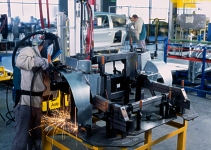
. . .
.. . . . Renault Concepts Renault Cars Related Topics
© 1998 - 2005 Copyright
& |
.
Renault Passenger Car Manufacturing: Plant Sandouville
Covering 152 hectares, including 51 hectares of buildings, the Sandouville plant has specialized in manufacturing Renault's top-of-the-range vehicles since its was built in 1964. With a workforce of over 6,000 people, it accounts for 10 % of Renault production (cars + LCVs) and constitutes a major regional economic hub in Normandy (north-west France). The launches of the new Laguna II vehicles and Vel Satis have led Renault to invest in a thorough modernization of its industrial facilities at Sandouville in order to make the plant more flexible and to focus the industrial process on the operations that bring value added to the end customer. To date Renault has invested FRF 4.25 billion (EUR 647.9 million) in renovating production systems at Sandouville. This sum includes: FRF 1.8 billion (EUR 274.5 million) for stamping; FRF 1.4 billion (EUR 213.4 million) for body assembly, which is 95 % automated with 400 robots capable of dealing with the different vehicle types; FRF 550 million (EUR 83.8 million) for painting, which enhances protection against corrosion; FRF 500 million (EUR 76.2 million) for final assembly, which has also benefited in terms of ergonomic improvements made to work stations. A revolutionary new approach to management Industrial modernization has been accompanied by an ambitious programme of team motivation at the Sandouville plant. Indeed, manufacturing top-of-the-range vehicles such as Vel Satis requires a management structure capable of rousing enthusiasm, notably via appropriate training programmes. Operators at Sandouville have been part of the X 73 project from as early as the design phase. During the manufacturing phase of Vel Satis, all personnel at the plant took part in an "awareness process", in which the themes of quality and customer expectations were considered in terms of project goals and issues. Sandouville is, furthermore, the pilot plant for the establishment of "operator skills courses", in which assembly personnel practice operating motions. Renault took its inspiration for this from a procedure observed at Nissan. There, the Nissan Production Way puts the work station at the heart of the industrial organization and standardizes the body movements at each particular station down to the smallest gesture. Such an organization allows factory productivity and product quality to be optimized, whilst galvanizing teams around the issues at stake in the programme. An Industrial Supplier Park for greater industrial efficiency
This move to locate suppliers on the site of the plant itself was accompanied by a strengthening of links with first tier partners involved in the development and manufacturing of important vehicle functions. The companies present on the site ensure secure and synchronized supply to the Vel Satis assembly line, thus reducing the surface area and volume of stocked materials. Construction of the Industrial Supplier Park cost FRF 80 million (EUR 12.2 million). Investment in the buildings was financed by Renault with funding from local, regional and national authorities to the tune of 20 %. Source : Renault
|












